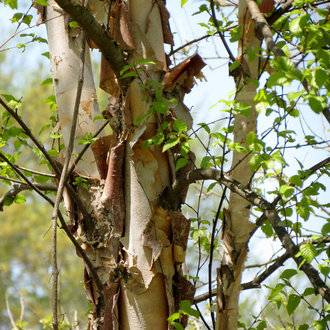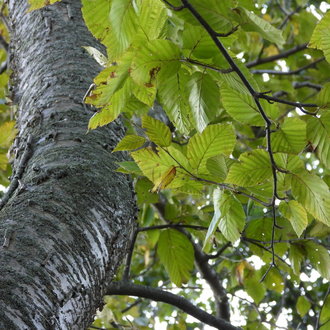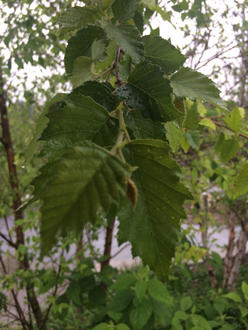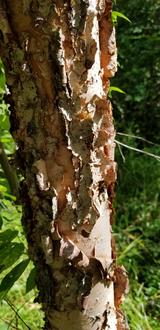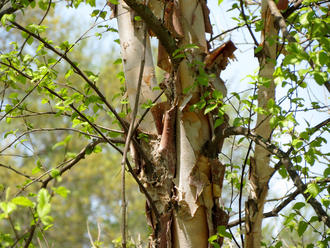River Birch (Betula nigra L.)
↑Summary
A birch of the southeast to central U.S., mostly associated with bottomlands and alluvial soils; the most southerly birch in North America and the only birch in much of its range.
↑Similar Plants
↑Habitat
Mostly found on in bottomlands, floodplains and streambanks, and lake margins, in early-successional habitat. Most common on newly-deposited land such as sand and gravel deposited on the inside of a curve. Occasionally found on upland sites.
Found on a variety of soils, but prefers alluvial soils, and also more common on clay soils, and prefers soils that stay at or near field capacity (consistently moist) year-round. Tolerates poor drainage, including prolonged flooding (for less than 1/4 the growing season), or soils that are waterlogged for about half the time. Tolerates acidic soils, including soils too acidic for most hardwoods, with a pH as low as 2, but also found on high pH soils. Intolerant of shade. Mature trees exhibit some tolerance to surface fires.
Found in a wide range of bottomland forests and swamps, but usually limited to earlier successional stages of growth, and requires disturbance to persist. River birch is a pioneer species, either the first to arrive on new or exposed ground, or arriving shortly after alders or willows.
Can be found in habitats that may experience fire at 5 to 8 year intervals, but usually absent from habitats with more frequent fire.
↑Life Cycle
River birch is a fast-growing, but usually short-lived pioneer species.
Trees produce a consistent seed crop most years. Unlike most birches, whose seed matures later, the seeds of this species mature in late spring to early summer, and are distributed immediately. The seeds are winged and distributed to some degree by wind, but are larger and heavier than the seeds of some birch species, and also rely signficantly on water for distribution, particularly to deposit the seeds on the suitable sites such as sandbars and streambanks.
Many seeds germinate immediately, within a few days of falling. On suitable sites, seedlings often form dense thickets. It is not known whether this species forms a seed bank, but the fact that many birch seeds have seed banks persisting as long as 8 years, and the presence of a germination inhibitor in the seeds, combined with the ability to germinate seeds later under artificial conditions, suggests that this species may form a persistent seed bank.
Growth is fast, but the specifics of growth rate of this species have not been thoroughly studied.
Although this species does not spread vegetatively, resprouts from a stump are common, often leading trees to grow with multiple trunks.
Trees typically live to around 75 years of age. Young trees are commonly damaged by floating ice, and trees of any age can be damaged by prolonged flooding or by severe fire.
↑Faunal Associations
The relatively large seeds are more attractive to larger birds, including grouse and wild turkey.
↑Uses
Used as a landscaping plant, where it is valued for its visually-interesting bark, attractive foliage, and moderate to small size at maturity, and ability to withstand both standing water and drought. This is the most heat-tolerant of the North American birches and the only birch that grows well in most of the southeastern to south-central US.
This species is of low importance for wood. Although the wood is hard, strong, close-grained, and easily workable, it is highly susceptible to rot and decay, and it also tends to be too knotty to be used for commercial lumber. Like other birches, the most common uses are for pulpwood, especially for plywood, and for veneer. Because the wood tends to be stronger and lighter than other birches, it is sometimes used for toys and artificial limbs. However, most trees are mixed together with other bottomland hardwoods during harvest, and used for pulpwood.
River birch has a high value for erosion control and land reclamation, including on former strip mines, where its tolerance of high acidity allows it to grow where few other plants can survive. River birch often establishes on its own on sites contaminated by acid mine spoils.
↑Links & External Resources
• River Birch | The Wood Database (About This Site)
• River Birch | Fire Effects Information System (FEIS) (About This Site)
• Betula nigra (River Birch) | Illinois Wildflowers (About This Site)
• Betula nigra (River Birch) | USDA PLANTS Database (About This Site)
• Betula nigra | Go Botany (About This Site)
• Betula nigra (River Birch) | Missouri Botanical Garden Plant Finder (About This Site)
• River Birch | Virginia Tech Dendrology Factsheets (About This Site)
• River Birch | Silvics of North America (About This Site)
• Betula nigra | Biota of North America Project (BONAP) (About This Site)
• Betula nigra | NatureServe Explorer (About This Site)
• Betula nigra | Flora of North America (About This Site)
• Betula nigra | Missouri Plants (About This Site)
• River Birch | Maryland Biodiversity Project (About This Site)
• Betula nigra L. (River Birch, Red Birch) | Digital Atlas of the Virginia Flora (About This Site)



